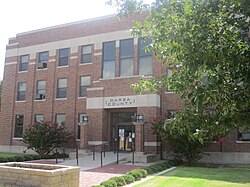Garza County
| Garza County, Texas | |
|---|---|

Garza County Courthouse in Post
|
|
 Location in the U.S. state of Texas |
|
 Texas's location in the U.S. |
|
| Founded | 1907 |
| Seat | Post |
| Largest city | Post |
| Area | |
| • Total | 896 sq mi (2,321 km2) |
| • Land | 893 sq mi (2,313 km2) |
| • Water | 2.8 sq mi (7 km2), 0.3% |
| Population | |
| • (2010) | 6,461 |
| • Density | 7.2/sq mi (3/km²) |
| Congressional district | 19th |
| Time zone | Central: UTC-6/-5 |
| Website | www |
Garza County is a county located in the U.S. state of Texas. As of the 2010 census, its population was 6,461. Its county seat is Post. The county was created in 1876 and later organized in 1907. Garza is named for a pioneer Bexar County family, as it was once a part of that county. It is located southeast of Lubbock.
A leading civic figure in Garza County was until his death in 2011 Giles McCrary, a rancher, oil developer, investor, and art collector. McCrary's OS Ranch Museum is a popular attraction in the county seat of Post, which has made an extended effort to attract tourism.
Republican Drew Springer, Jr., a businessman from Muenster in Cooke County, has since January 2013 represented Garza County in the Texas House of Representatives.
According to the U.S. Census Bureau, the county has a total area of 896 square miles (2,320 km2), of which 893 square miles (2,310 km2) is land and 2.8 square miles (7.3 km2) (0.3%) is water.
As of the census of 2000, there were 4,872 people, 1,663 households, and 1,217 families residing in the county. The population density was 5 people per square mile (2/km²). There were 1,928 housing units at an average density of 2 per square mile (1/km²). The racial makeup of the county was 56.7% White (European and non-Hispanic), 4.8 Black or African American, 0.2% Native American, 0.1% Asian, 0.0% Pacific Islander, 37.2% of the population were Hispanic or Latino. 17.1 other races, and 3.00% from two or more races.
...
Wikipedia
